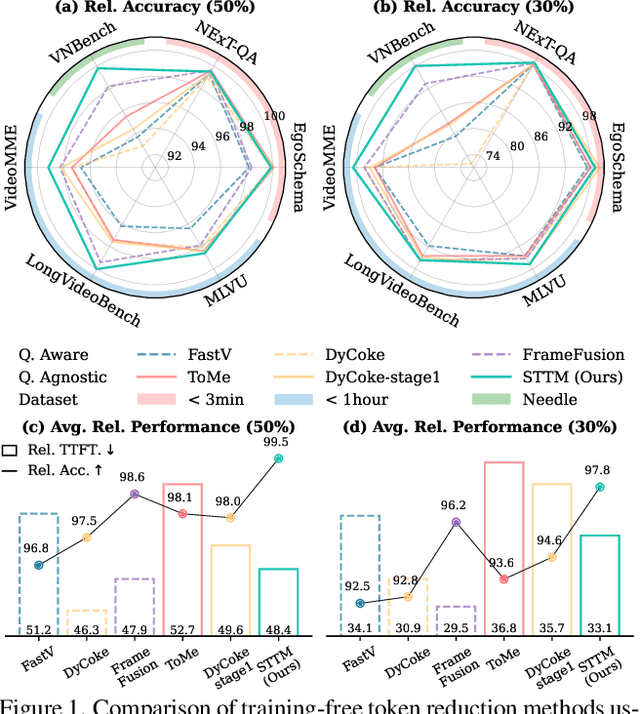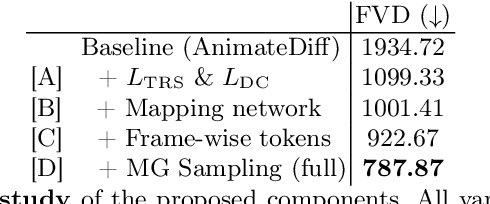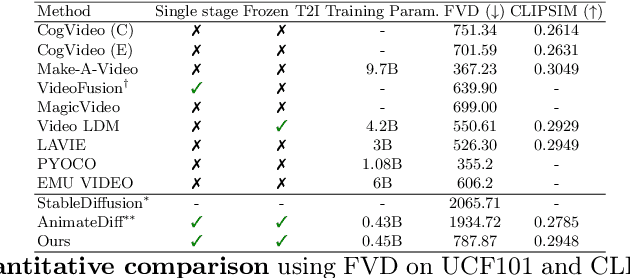Joon-Young Lee
Multi-Granular Spatio-Temporal Token Merging for Training-Free Acceleration of Video LLMs
Jul 10, 2025



Abstract:Video large language models (LLMs) achieve strong video understanding by leveraging a large number of spatio-temporal tokens, but suffer from quadratic computational scaling with token count. To address this, we propose a training-free spatio-temporal token merging method, named STTM. Our key insight is to exploit local spatial and temporal redundancy in video data which has been overlooked in prior work. STTM first transforms each frame into multi-granular spatial tokens using a coarse-to-fine search over a quadtree structure, then performs directed pairwise merging across the temporal dimension. This decomposed merging approach outperforms existing token reduction methods across six video QA benchmarks. Notably, STTM achieves a 2$\times$ speed-up with only a 0.5% accuracy drop under a 50% token budget, and a 3$\times$ speed-up with just a 2% drop under a 30% budget. Moreover, STTM is query-agnostic, allowing KV cache reuse across different questions for the same video. The project page is available at https://www.jshyun.me/projects/sttm.
Learning to Track Any Points from Human Motion
Jul 08, 2025



Abstract:Human motion, with its inherent complexities, such as non-rigid deformations, articulated movements, clothing distortions, and frequent occlusions caused by limbs or other individuals, provides a rich and challenging source of supervision that is crucial for training robust and generalizable point trackers. Despite the suitability of human motion, acquiring extensive training data for point tracking remains difficult due to laborious manual annotation. Our proposed pipeline, AnthroTAP, addresses this by proposing an automated pipeline to generate pseudo-labeled training data, leveraging the Skinned Multi-Person Linear (SMPL) model. We first fit the SMPL model to detected humans in video frames, project the resulting 3D mesh vertices onto 2D image planes to generate pseudo-trajectories, handle occlusions using ray-casting, and filter out unreliable tracks based on optical flow consistency. A point tracking model trained on AnthroTAP annotated dataset achieves state-of-the-art performance on the TAP-Vid benchmark, surpassing other models trained on real videos while using 10,000 times less data and only 1 day in 4 GPUs, compared to 256 GPUs used in recent state-of-the-art.
FRAME: Pre-Training Video Feature Representations via Anticipation and Memory
Jun 05, 2025Abstract:Dense video prediction tasks, such as object tracking and semantic segmentation, require video encoders that generate temporally consistent, spatially dense features for every frame. However, existing approaches fall short: image encoders like DINO or CLIP lack temporal awareness, while video models such as VideoMAE underperform compared to image encoders on dense prediction tasks. We address this gap with FRAME, a self-supervised video frame encoder tailored for dense video understanding. FRAME learns to predict current and future DINO patch features from past and present RGB frames, leading to spatially precise and temporally coherent representations. To our knowledge, FRAME is the first video encoder to leverage image-based models for dense prediction while outperforming them on tasks requiring fine-grained visual correspondence. As an auxiliary capability, FRAME aligns its class token with CLIP's semantic space, supporting language-driven tasks such as video classification. We evaluate FRAME across six dense prediction tasks on seven datasets, where it consistently outperforms image encoders and existing self-supervised video models. Despite its versatility, FRAME maintains a compact architecture suitable for a range of downstream applications.
Seurat: From Moving Points to Depth
Apr 20, 2025Abstract:Accurate depth estimation from monocular videos remains challenging due to ambiguities inherent in single-view geometry, as crucial depth cues like stereopsis are absent. However, humans often perceive relative depth intuitively by observing variations in the size and spacing of objects as they move. Inspired by this, we propose a novel method that infers relative depth by examining the spatial relationships and temporal evolution of a set of tracked 2D trajectories. Specifically, we use off-the-shelf point tracking models to capture 2D trajectories. Then, our approach employs spatial and temporal transformers to process these trajectories and directly infer depth changes over time. Evaluated on the TAPVid-3D benchmark, our method demonstrates robust zero-shot performance, generalizing effectively from synthetic to real-world datasets. Results indicate that our approach achieves temporally smooth, high-accuracy depth predictions across diverse domains.
Tuning-Free Multi-Event Long Video Generation via Synchronized Coupled Sampling
Mar 11, 2025Abstract:While recent advancements in text-to-video diffusion models enable high-quality short video generation from a single prompt, generating real-world long videos in a single pass remains challenging due to limited data and high computational costs. To address this, several works propose tuning-free approaches, i.e., extending existing models for long video generation, specifically using multiple prompts to allow for dynamic and controlled content changes. However, these methods primarily focus on ensuring smooth transitions between adjacent frames, often leading to content drift and a gradual loss of semantic coherence over longer sequences. To tackle such an issue, we propose Synchronized Coupled Sampling (SynCoS), a novel inference framework that synchronizes denoising paths across the entire video, ensuring long-range consistency across both adjacent and distant frames. Our approach combines two complementary sampling strategies: reverse and optimization-based sampling, which ensure seamless local transitions and enforce global coherence, respectively. However, directly alternating between these samplings misaligns denoising trajectories, disrupting prompt guidance and introducing unintended content changes as they operate independently. To resolve this, SynCoS synchronizes them through a grounded timestep and a fixed baseline noise, ensuring fully coupled sampling with aligned denoising paths. Extensive experiments show that SynCoS significantly improves multi-event long video generation, achieving smoother transitions and superior long-range coherence, outperforming previous approaches both quantitatively and qualitatively.
Exploring Temporally-Aware Features for Point Tracking
Jan 21, 2025Abstract:Point tracking in videos is a fundamental task with applications in robotics, video editing, and more. While many vision tasks benefit from pre-trained feature backbones to improve generalizability, point tracking has primarily relied on simpler backbones trained from scratch on synthetic data, which may limit robustness in real-world scenarios. Additionally, point tracking requires temporal awareness to ensure coherence across frames, but using temporally-aware features is still underexplored. Most current methods often employ a two-stage process: an initial coarse prediction followed by a refinement stage to inject temporal information and correct errors from the coarse stage. These approach, however, is computationally expensive and potentially redundant if the feature backbone itself captures sufficient temporal information. In this work, we introduce Chrono, a feature backbone specifically designed for point tracking with built-in temporal awareness. Leveraging pre-trained representations from self-supervised learner DINOv2 and enhanced with a temporal adapter, Chrono effectively captures long-term temporal context, enabling precise prediction even without the refinement stage. Experimental results demonstrate that Chrono achieves state-of-the-art performance in a refiner-free setting on the TAP-Vid-DAVIS and TAP-Vid-Kinetics datasets, among common feature backbones used in point tracking as well as DINOv2, with exceptional efficiency. Project page: https://cvlab-kaist.github.io/Chrono/
Generative Video Propagation
Dec 27, 2024Abstract:Large-scale video generation models have the inherent ability to realistically model natural scenes. In this paper, we demonstrate that through a careful design of a generative video propagation framework, various video tasks can be addressed in a unified way by leveraging the generative power of such models. Specifically, our framework, GenProp, encodes the original video with a selective content encoder and propagates the changes made to the first frame using an image-to-video generation model. We propose a data generation scheme to cover multiple video tasks based on instance-level video segmentation datasets. Our model is trained by incorporating a mask prediction decoder head and optimizing a region-aware loss to aid the encoder to preserve the original content while the generation model propagates the modified region. This novel design opens up new possibilities: In editing scenarios, GenProp allows substantial changes to an object's shape; for insertion, the inserted objects can exhibit independent motion; for removal, GenProp effectively removes effects like shadows and reflections from the whole video; for tracking, GenProp is capable of tracking objects and their associated effects together. Experiment results demonstrate the leading performance of our model in various video tasks, and we further provide in-depth analyses of the proposed framework.
Elevating Flow-Guided Video Inpainting with Reference Generation
Dec 12, 2024Abstract:Video inpainting (VI) is a challenging task that requires effective propagation of observable content across frames while simultaneously generating new content not present in the original video. In this study, we propose a robust and practical VI framework that leverages a large generative model for reference generation in combination with an advanced pixel propagation algorithm. Powered by a strong generative model, our method not only significantly enhances frame-level quality for object removal but also synthesizes new content in the missing areas based on user-provided text prompts. For pixel propagation, we introduce a one-shot pixel pulling method that effectively avoids error accumulation from repeated sampling while maintaining sub-pixel precision. To evaluate various VI methods in realistic scenarios, we also propose a high-quality VI benchmark, HQVI, comprising carefully generated videos using alpha matte composition. On public benchmarks and the HQVI dataset, our method demonstrates significantly higher visual quality and metric scores compared to existing solutions. Furthermore, it can process high-resolution videos exceeding 2K resolution with ease, underscoring its superiority for real-world applications.
HARIVO: Harnessing Text-to-Image Models for Video Generation
Oct 10, 2024



Abstract:We present a method to create diffusion-based video models from pretrained Text-to-Image (T2I) models. Recently, AnimateDiff proposed freezing the T2I model while only training temporal layers. We advance this method by proposing a unique architecture, incorporating a mapping network and frame-wise tokens, tailored for video generation while maintaining the diversity and creativity of the original T2I model. Key innovations include novel loss functions for temporal smoothness and a mitigating gradient sampling technique, ensuring realistic and temporally consistent video generation despite limited public video data. We have successfully integrated video-specific inductive biases into the architecture and loss functions. Our method, built on the frozen StableDiffusion model, simplifies training processes and allows for seamless integration with off-the-shelf models like ControlNet and DreamBooth. project page: https://kwonminki.github.io/HARIVO
Local All-Pair Correspondence for Point Tracking
Jul 22, 2024Abstract:We introduce LocoTrack, a highly accurate and efficient model designed for the task of tracking any point (TAP) across video sequences. Previous approaches in this task often rely on local 2D correlation maps to establish correspondences from a point in the query image to a local region in the target image, which often struggle with homogeneous regions or repetitive features, leading to matching ambiguities. LocoTrack overcomes this challenge with a novel approach that utilizes all-pair correspondences across regions, i.e., local 4D correlation, to establish precise correspondences, with bidirectional correspondence and matching smoothness significantly enhancing robustness against ambiguities. We also incorporate a lightweight correlation encoder to enhance computational efficiency, and a compact Transformer architecture to integrate long-term temporal information. LocoTrack achieves unmatched accuracy on all TAP-Vid benchmarks and operates at a speed almost 6 times faster than the current state-of-the-art.
 Add to Chrome
Add to Chrome Add to Firefox
Add to Firefox Add to Edge
Add to Edge